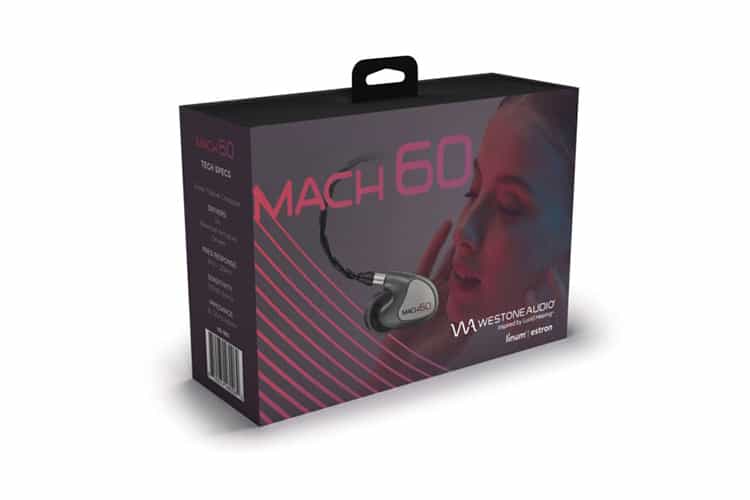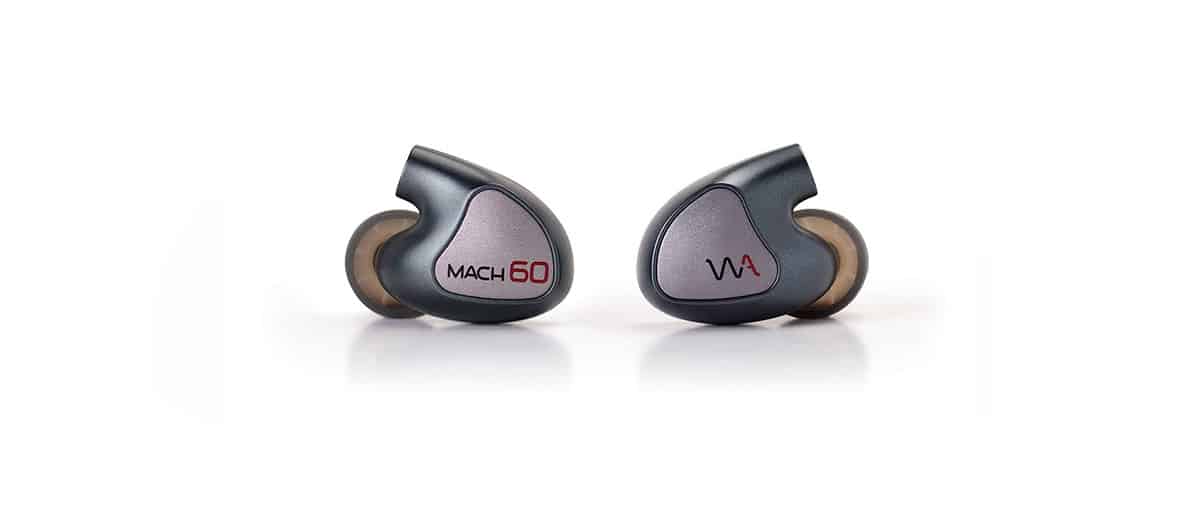Synergy
Rated at 35Ω and 100dB in sensitivity, the MACH 60 is easier to drive than the MACH 80. However, it is definitely not the most sensitive IEM in the market, and it does require some good power to get it to full swing.
On most outputs, the MACH 60 is completely quiet in the background due to its slightly high impedance rating and moderately low sensitivity.
It also sounds consistent with different outputs. The most prominent difference you might hear when switching gear would be the brightness in the upper mids, influenced by the power and gain from the source.
The MACH 60 can sound very loud and satisfactorily dynamic and meaty in the lows with my MacBook Pro. It certainly gets along better with stronger sources like the Shanling M6 Pro 21, and the FiiO M11 Plus ESS.
It is enjoyably flat on reference gears like the RME ADI-2 Pro and with audiophile amplifiers like the FiiO K9 Pro ESS and the Soncoz SGA1, it will get more exciting in the upper mids. Especially when you push the gain to higher levels to bring up the intensity and attack power of the 5kHz region.
You could expect decent dynamics on USB-powered devices/interfaces, but gear with A/C plugged on or with stronger outputs will definitely give it a good kick.
Outside of power, the tuning on the source can also help the MACH 60 sound more resolving, though this may not be the intention of the design. With high gain on the Shanling M7 as an example, the MACH 60 sounds much cleaner and a tad bit brighter in the upper vocal range including the upper register which, in turn, more penetration power to softer voices.
Select Comparisons
Westone Audio MACH 70
$1399
Technical
The MACH 70 has one more driver with a 1 bass, 2 mids, and a quad treble configuration in contrast to the MACH ’60s dual bass, two mids, and two treble driver configuration.
The MACH 70 seems much more treble-leaned just by looking at its driver configuration, but it is actually quite a bit more bass-heavy. The MACH 70 is easier to drive with its 110dB in sensitivity, 10% more sensitive than the MACH 60.
Design
There is very little visual difference except in the color scheme, whereas the MACH 60 has a lighter grey paint job. The cable is also different where the MACH 70 is equipped with ULTRABaX and the MACH 60 with SuperBaX LINUM cables, giving it a more subtle look instead of a premium audiophile appeal.
Performance
Even though both are siblings down the MACH series, you can tell them from each other instantly as their sound signature is vastly different, and so also their response to power.
When paired with the laptop it is clear that the MACH 70 is easier to drive to sound louder, firmer, and more dynamic. The MACH 70 is more elevated on both ends, resulting in bigger bass, clearer vocal, and sharper cymbal attacks, whereas the MACH 60 feels flatter and less strong in transients.
The difference in tuning is less prominent on more powerful devices. The MACH 60 catches up to sound firmer and has the clarity and vocal forwardness boosted especially on higher gain. Also, there is more room for it to cope with strong bass mixes or screaming loud voices with that softer treble tuning.
In general, the MACH 60 sounds more polite in the lows and the upper vocal range. It is more even in energy distribution and less altered, which aligns with its position as a monitoring IEM.
The MACH 70 is more colored and brighter, lifting the two ends for dynamics with a stronger sense of resolution. The energy on the MACH 70 contrasts with the soothing tuning on the MACH 60 which sounds more relaxing and non-fatiguing.
Westone Audio MACH 40
$599
Technical
The MACH 40 with dual lows, 1 midrange, and 1 treble balanced armature driver is the most affordable IEM in the “Premium Reference” line.
The frequency response range is stated as 10Hz-20kHz which is not as broad as the MACH 60 rating and the sensitivity is the same 100dB @1kHz as measured with the MACH 60. One bigger difference you may have spotted is its impedance rating of 30Ω @1kHz, which is 5Ω lower than that of the MACH 60.
Design
The MACH 40 and MACH 60 look nearly identical, and they come with the same stock cable so you may not be able to tell them from each other save for the printed labeling on the shells.
Performance
The driver configuration does tell something about the signature on the MACH 40, which leans more to the bass side this time with a higher bass driver ratio.
With just one driver each for the mids and treble the definition in the vocal range and the overtones are not as strong as on the MACH 60, but the vocal, especially darker voices are still nearly as powerful and weighted in the low-end.
While the MACH 60 sounds neutral and smoothly articulated in the mid-range that is sweetened by well-controlled upper mids, the MACH 40 is much shyer and darker.
You can easily detect it with violins and softer voices where the penetration power is more limited. It feels like listening in a more dampened and smaller room, where the exciting parts of the output are smoothened out for the listener to calmly oversee the whole picture.
The treble feels smoother on the MACH 40 due to an earlier roll-off. You can feel some of the sheen and air has gone compared to the MACH 60, with hi-hats, flutes, or bell sounds falling back a little bit.
The MACH 60 is comprehensively stronger with better balance, transparency, and speed. It is also lusher sounding with a more energetic vocal. the MACH 40 has a slightly stronger focus on the lower end and less energy in the upper register, which may compensate for ambient noise better and sound more relaxing when listening to it in noisy environments.
FAudio Dark Sky
$1150
Technical
The FAudio Dark Sky is equipped with a 10.2mm double diaphragm single dynamic driver (fiber & D.L.C.) housed in a patented acoustic chamber, it is rated at 24Ω @1kHz and 114dB @1kHz in sensitivity. It is definitely more sensitive than the MACH 60 and could be easily powered by DAPs like the Sony WM1A.
Design
The Dark Sky has the same DNA as seen on other FAudio items, using the brand’s consistent housing design as well as putting together a premium-looking stock cable.
Its modish and sporty design is styled very differently from the stealthier and more industrial-looking MACH 60 which is designed not only for audiophiles but for music production as well.
The Dark Sky has a balanced connector in default and can be converted to 3.5mm with the supplied adaptor. While the MACH 60 supports only the 3.5mm single-ended standard which is still dominating mixing gears and receivers. The diversion makes sense for the proposed usage scenario and both IEMs are appealing in their own ways.
Performance
The Dark Sky is more sensitive than the MACH 60 while being more fun in its tuning having its low-end and overtone frequencies elevated. Moreover, it is fast in attack and has a clean decay enabled by the very rigid driver membrane. It sounds quite different from the commonly slower and fatter bass on many other DD IEMs.
The MACH 60 has good fullness and air in its bass despite the fact that it has an extended nozzle of a much smaller diameter and a much smaller profile that always poses a challenge to bass power. Actually, both IEMs are doing a great job for bass-to-midrange articulation sounding elaborated, expressive, and detailed.
The Dark Sky mids are more focused on the two ends making it not as revealing and rich as on the MACH 60. The MACH 60’s midrange has more body and there is stronger vocal authority and naturalness preserved.
The treble is spotlighted on the Dark Sky, working well on dance, and electronic music that stresses the beats and synthesized bass, with the smooth recessed midrange leaving out more space for the treble to be clearly heard.
The MACH 60 doesn’t sound as intensive even when given higher gain and power and maintains good dynamics and a stronger sense of control. The milder treble on the MACH 60 gives more attention to the backing instruments or darker, fuller voices.

Our Verdict
With a six-driver BA design, the Westone Audio MACH 60 pulls off a balanced, natural, and unaltered tuning proposition with decent bass quality and stereographically imaged vocals.
The treble isn’t as embellished as on the MACH 80 and seems to be offering a stronger tolerance on heavy treble content. This leaves more room for users to explore its capability with powerful and clean-sounding gear.
The more friendly price and specific tuning profile will appeal not only to professional users but audiophiles who seek a tuning profile that can interpret different genres of music with good authority.
Westone Audio MACH 60 Technical Specifications
- 3-way Passive Crossover
- Drivers: Six Balanced-Armature Drivers
- Frequency response: 8Hz – 20kHz
- Sensitivity: 100dB @1kHz
- Impedance: 35Ω @1kHz




